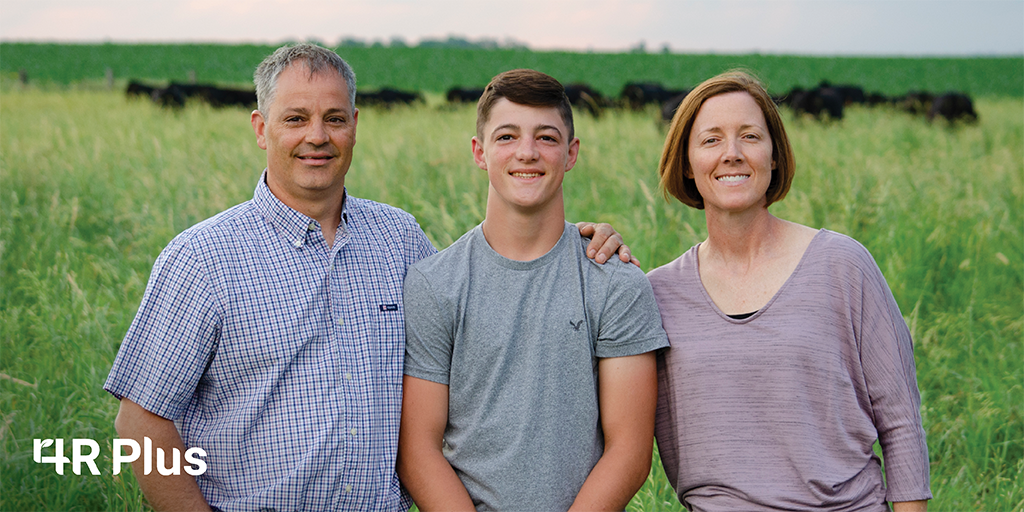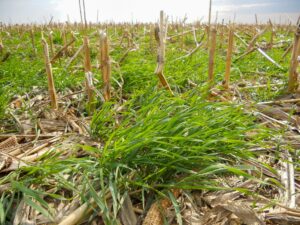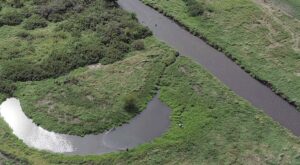By: 4R Plus
January 2022

Photo: Iowa Cattlemen’s Association
Finding the right balance is a common theme when Justin Robbins talks about his farm. He has expanded his operation to around 1,500 acres of corn and soybean production and 500 acres of pasture and hay ground located largely in Greene County. He has roughly 200 head of certified Angus cows and the bulk of his pastures are along the North Racoon watershed. Besides the challenges presented by the river’s proximity, his ground also features hills and valleys.
Robbins, who farms with his family and a now-retired mentor/business partner, said he’s been able to work with others like his mechanic or agronomist to spread the load and “do more of what I enjoy: figuring out how to make the soil better for the next generation by making crucial water and soil conservation decisions. I want more yield with less input. I want the ground to do more because I took care of it.”
He likens the ground to a body that needs to be fed. “When you’re low on energy, you may grab a candy bar for a quick boost, right? But you probably should have just thrown a steak on the grill the night before,” he said. “I think we can utilize the tools we have available a little better to put the proper nutrition in the soil.”
Driven to improve water quality and soil health
Robbins has invested a lot of time and effort bettering his pasture ground, improving water quality and supporting wildlife. He’s the 2021 Iowa Cattlemen’s Association’s Environmental Stewardship Award Winner, and he has spent countless hours clearing brush, repairing ravines and overrun areas, adding drain tile and installing rolling dams. He has seeded rye along barren riverside ground, sectioned off creek beds and built and rebuilt ponds.

Photo: Iowa Cattlemen’s Association
“If we can use rotational grazing on a pasture, we most certainly do,” he said. Some years, he also mows and bales pasture ahead of cows to “utilize forage in a better way and to keep it growing all the time.” He has also converted some of his harder-to-manage crop acres into hay or pasture ground.
Robbins seeded cover crops on around half of the soybean acres in 2021 and said he will continue to expand that practice because he sees the benefits.
The cover crop helped suppress volunteer corn and enabled him to avoid a pre-planting herbicide application. “Over the duration of my cover crops, I have saved money because I typically do not have to put anything on,” Robbins observed.
Revenue per acre informs his decisions more so than bushels per acre. “I look at things a little differently. I don’t have to have 50-bushel-per-acre soybeans, because I already took off a feed source that generated dollars,” he explained.
Keeping an open mind when it comes to best practices
Robbins has a unique approach when it comes to drowned out areas of a field. In a normal year, he will wait until June 1 and then seed rye or oats along with turnips and radishes to break that hardpan or pond. “Doing so creates a buffer to the intake and pulls out and utilizes the extra nitrogen,” he said. “It grows like a house on fire, and it’s very cheap feed.”
Some of his farms have very high organic matter due to years of spreading manure. To troubleshoot, Robbins bales those fields in the fall, which removes quite a bit of the corn stover. He then goes back in with a light rate of composted bedding pack and plants cover crops. Others have warned this could cause nitrogen problems, but he said it’s “helping our herbicide program and yields.”
A changed mindset toward conservation
Robbins is accustomed to adjusting on the fly and trying the unbeaten path. “Livestock has shown me I cannot get in the tractor at 7 a.m. and go north and south,” he said. “I have to be prepared for a curveball that might delay fieldwork.”
He’s also willing to stop what he’s doing to fix a washout versus keeping up with the neighbors’ planting pace. “We have to change our mindsets and evaluate what’s right for each farm,” Robbins said.
He encourages producers to experiment and think through conservation practices like fertilizing rather than doing them simply because everyone else is. “Sometimes less is more,” he said. “If you do the small things right, the big things fall into place.”
Find more 4R Plus success stories or check out Robbins’ online store offering homegrown beef.



